-
Out of stock
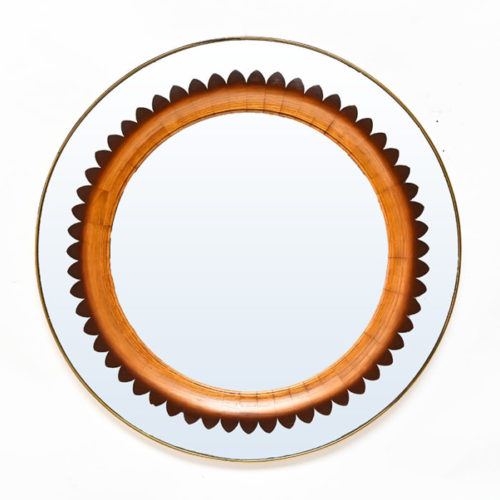 Rare mirror by Pier Luigi Colli for Marelli from the 1950s, in elm wood, antique mirror and brass finishes, original and in excellent condition. Period: 1950s Measurements: Ø 100 x D 5
Rare mirror by Pier Luigi Colli for Marelli from the 1950s, in elm wood, antique mirror and brass finishes, original and in excellent condition. Period: 1950s Measurements: Ø 100 x D 5 -
Out of stock
 Pair of original crimson velvet armchairs. 1950s style by Gio Ponti. Backrest with shell shape, truncated conical feet with brass ends. In good condition, the matching sofa is also for sale. Period: 1950 Measurements: H 82 L 90 P 88 (H seat 50) cm
Pair of original crimson velvet armchairs. 1950s style by Gio Ponti. Backrest with shell shape, truncated conical feet with brass ends. In good condition, the matching sofa is also for sale. Period: 1950 Measurements: H 82 L 90 P 88 (H seat 50) cm -
Out of stock
 Gio Ponti style sofa in the original crimson velvet. Backrest with shell shape, 6 truncated conical feet with brass ends. In good condition, also the pair of matching armchairs for sale. Period: 1950 Measurements: H 82 L 186 D 88 (H seat 50) cm
Gio Ponti style sofa in the original crimson velvet. Backrest with shell shape, 6 truncated conical feet with brass ends. In good condition, also the pair of matching armchairs for sale. Period: 1950 Measurements: H 82 L 186 D 88 (H seat 50) cm -
Out of stock
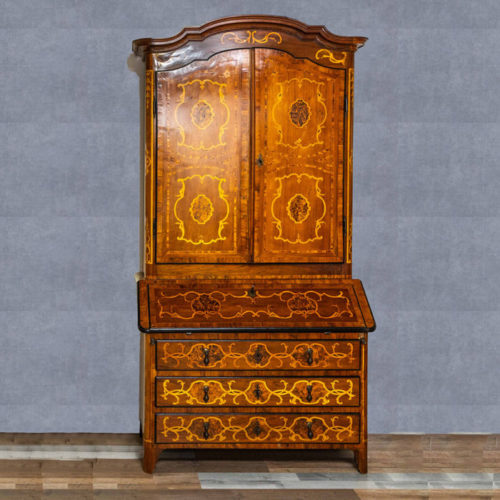 Mid-eighteenth-century Louis XV Piedmontese trumeau, in walnut with maple scrollwork inlays. Excellent condition, some inlays have been replaced with rice paste. Period: Half 700 Measurements: H 250 x W 131 x D 61.5 cm
Mid-eighteenth-century Louis XV Piedmontese trumeau, in walnut with maple scrollwork inlays. Excellent condition, some inlays have been replaced with rice paste. Period: Half 700 Measurements: H 250 x W 131 x D 61.5 cm -
Out of stock
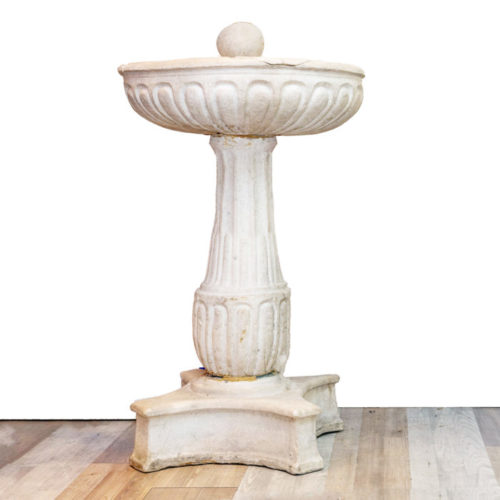 Ancient stoup in carved white marble, 17th century in good condition. Period: '600 Measurements: H 130 x D 64 cm
Ancient stoup in carved white marble, 17th century in good condition. Period: '600 Measurements: H 130 x D 64 cm -
Out of stock
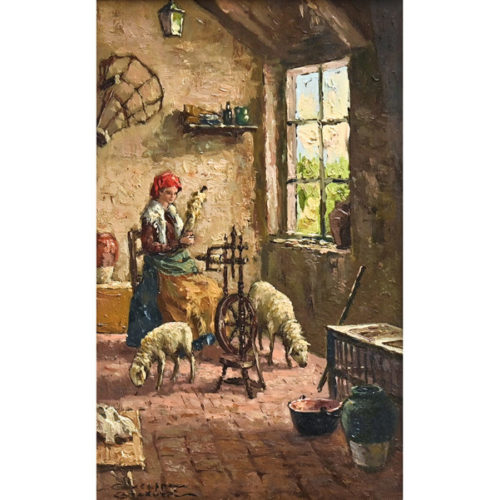 "Interior with thread spinner and sheep". Oil on tablet by Giuseppe Gheduzzi . The artist was born in Crespellano (BO) on 12 May 1889. Son of the painter Ugo, from whom he learned, like his brothers Cesare, Mario and Augusto, the first rudiments of art. He made his debut in Vignola in 1907 with the painting Alpine landscape. He refined his training in Turin at the Albertina Academy as a pupil of Andrea Marchisio and Paolo Gaidano. After leaving the Academy, he collaborates with his father for the realization of the stage sets for the Teatro Regio. Giuseppe is a skilled landscape painter: he paints Venetian glimpses and panoramas, views of the Piedmontese lakes and valleys and of the Ligurian Riviera. Unlike his brother Cesare, however, he also excels in interior paintings with figures and orientalist themes. Particularly appreciated by the public and critics are in fact his genre scenes and the paintings depicting interiors of workshops of artisans, antique dealers and stables. During his life Giuseppe participated in many reviews of the Promoter of Fine Arts in Turin and in the Circolo degli Artisti in Turin, and made several personal exhibitions. He died in Turin on May 21, 1957. Period: 1930s Measurements: In frame H 36 x W 28 x D 3 / Canvas H 20 x W 11,5 cm
"Interior with thread spinner and sheep". Oil on tablet by Giuseppe Gheduzzi . The artist was born in Crespellano (BO) on 12 May 1889. Son of the painter Ugo, from whom he learned, like his brothers Cesare, Mario and Augusto, the first rudiments of art. He made his debut in Vignola in 1907 with the painting Alpine landscape. He refined his training in Turin at the Albertina Academy as a pupil of Andrea Marchisio and Paolo Gaidano. After leaving the Academy, he collaborates with his father for the realization of the stage sets for the Teatro Regio. Giuseppe is a skilled landscape painter: he paints Venetian glimpses and panoramas, views of the Piedmontese lakes and valleys and of the Ligurian Riviera. Unlike his brother Cesare, however, he also excels in interior paintings with figures and orientalist themes. Particularly appreciated by the public and critics are in fact his genre scenes and the paintings depicting interiors of workshops of artisans, antique dealers and stables. During his life Giuseppe participated in many reviews of the Promoter of Fine Arts in Turin and in the Circolo degli Artisti in Turin, and made several personal exhibitions. He died in Turin on May 21, 1957. Period: 1930s Measurements: In frame H 36 x W 28 x D 3 / Canvas H 20 x W 11,5 cm -
Out of stock
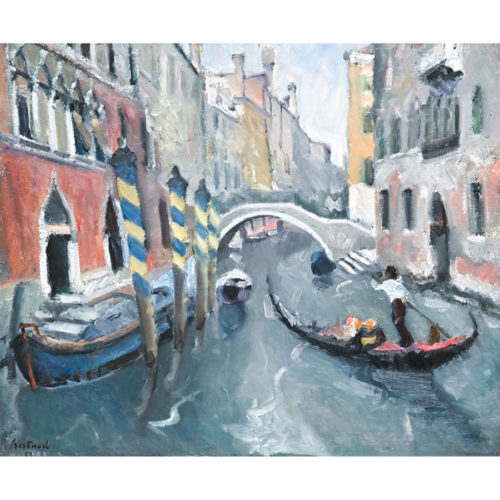 "Rio a Venezia (River in Venice)", 1953, oil on canvas by G. Bertulli. Born on August 16th, 1903 in Bardi (Parma), he lives in Milan. He studied in Piacenza, a pupil of Francesco Ghittoni, and in Milan, at the Brera academy, he then moved and settled in Milan and since then he participated in important local and national exhibitions, obtaining awards and prizes. To his credit about thirty solo exhibitions, of which six are in Milan and the last one (1967) at the Sagittario gallery. He was a member of the Accademia Clementina and the Parma Academy of Fine Arts. Trade union manager and member of the Commission for the Monumental at the Municipality of Milan. Dimensions: In frame H 68 x W 78 x D 5.5 / H 50 x L 60 cm
"Rio a Venezia (River in Venice)", 1953, oil on canvas by G. Bertulli. Born on August 16th, 1903 in Bardi (Parma), he lives in Milan. He studied in Piacenza, a pupil of Francesco Ghittoni, and in Milan, at the Brera academy, he then moved and settled in Milan and since then he participated in important local and national exhibitions, obtaining awards and prizes. To his credit about thirty solo exhibitions, of which six are in Milan and the last one (1967) at the Sagittario gallery. He was a member of the Accademia Clementina and the Parma Academy of Fine Arts. Trade union manager and member of the Commission for the Monumental at the Municipality of Milan. Dimensions: In frame H 68 x W 78 x D 5.5 / H 50 x L 60 cm -
Out of stock
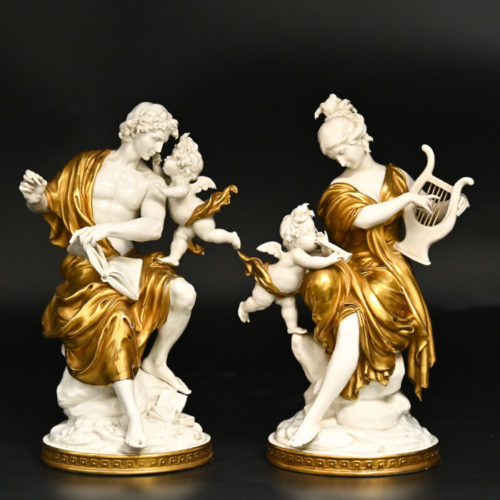 Pair of ceramics depicting the allegory of poetry and allegory of music, by Giuseppe CAPPÈ (1921-2008), ca. 1950s, in perfect condition. Giuseppè Cappè was born in Milan in 1921, he lived in Milan and later in Lomagna (Lecco) where in his studio, near the porcelain manufacturer, he created his works appreciated all over the world and which, especially in America, have conquered the market. Part of his works are now in many private collections and museums. Cappè was an artist who drew inspiration from the strands of the great Italian Baroque-Alexandrian folk tradition of which the stuccos of Serpotta (Palermo), the Capodimonte porcelain and the Neapolitan mangers are the most typical and well-known examples. Cappè was an artist who has been making sculptures since 1946 and his creations have been so successful that they have been imitated and plagiarized. He also worked as a chief sculptor at the IPA studio and later as a chief sculptor at King. Many of his models are still reproduced from these porcelain studies. He died in Lomagna on 7 May 2008. Measurements: (H 23 X L14 X P10), (H23 X L14 X P12)
Pair of ceramics depicting the allegory of poetry and allegory of music, by Giuseppe CAPPÈ (1921-2008), ca. 1950s, in perfect condition. Giuseppè Cappè was born in Milan in 1921, he lived in Milan and later in Lomagna (Lecco) where in his studio, near the porcelain manufacturer, he created his works appreciated all over the world and which, especially in America, have conquered the market. Part of his works are now in many private collections and museums. Cappè was an artist who drew inspiration from the strands of the great Italian Baroque-Alexandrian folk tradition of which the stuccos of Serpotta (Palermo), the Capodimonte porcelain and the Neapolitan mangers are the most typical and well-known examples. Cappè was an artist who has been making sculptures since 1946 and his creations have been so successful that they have been imitated and plagiarized. He also worked as a chief sculptor at the IPA studio and later as a chief sculptor at King. Many of his models are still reproduced from these porcelain studies. He died in Lomagna on 7 May 2008. Measurements: (H 23 X L14 X P10), (H23 X L14 X P12) -
Out of stock
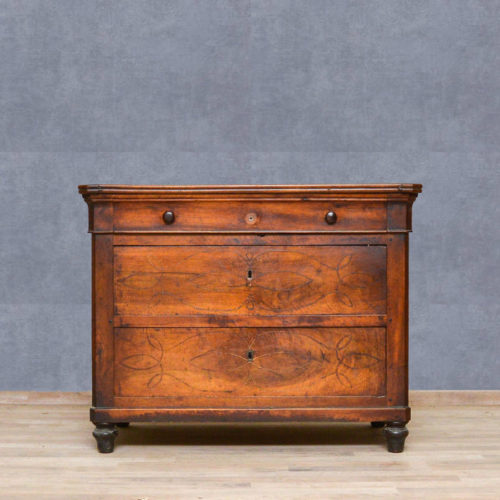 Small Piedmontese dresser in Luigi Filippo style. Two and a half drawers, turned foot, inlaid drawers in patina. In fair condition. Period: mid-19th century Measurements: H 84 x W 105 x D 54.5 cm
Small Piedmontese dresser in Luigi Filippo style. Two and a half drawers, turned foot, inlaid drawers in patina. In fair condition. Period: mid-19th century Measurements: H 84 x W 105 x D 54.5 cm -
Out of stock
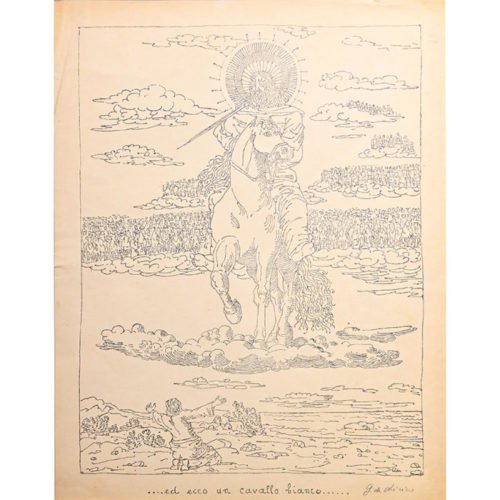 "Ed ecco un cavallo bianco (And finally a white horse)", a not numbered litograph, signed on the lower right by Giorgio De Chirico. This artwork is included in the "Apocalypse" volume, curated by R. Carrieri, Edizioni della Chimera, Milano. The founder of the metaphysical school, Giorgio de Chirico is mostly known for his metaphysical paintings, created from 1909 to 1919. These nostalgic representations have deeply influenced the Surrealist movement and its artists, among which André Breton, Salvador Dalì and René Magritte. De Chirico's artworks explore various themes, among which alientation; nostalgia and the myth. De Chirico refused, later in his career, his previous metaphysical style and focused his research on traditional painting techniques, preferring the neo-Classic and neo-Baroque style, influenced by Raffaello, Luca Signorelli and Peter Paul Rubens. The surrealists publicly criticised this further anti-moidernist development in De Chirico's work and for that the artist ceased his participation and belonging to the group. Measurements: In frame H53 x W45,5 x D1,5 cm / Litograph H32 x W25 cm.
"Ed ecco un cavallo bianco (And finally a white horse)", a not numbered litograph, signed on the lower right by Giorgio De Chirico. This artwork is included in the "Apocalypse" volume, curated by R. Carrieri, Edizioni della Chimera, Milano. The founder of the metaphysical school, Giorgio de Chirico is mostly known for his metaphysical paintings, created from 1909 to 1919. These nostalgic representations have deeply influenced the Surrealist movement and its artists, among which André Breton, Salvador Dalì and René Magritte. De Chirico's artworks explore various themes, among which alientation; nostalgia and the myth. De Chirico refused, later in his career, his previous metaphysical style and focused his research on traditional painting techniques, preferring the neo-Classic and neo-Baroque style, influenced by Raffaello, Luca Signorelli and Peter Paul Rubens. The surrealists publicly criticised this further anti-moidernist development in De Chirico's work and for that the artist ceased his participation and belonging to the group. Measurements: In frame H53 x W45,5 x D1,5 cm / Litograph H32 x W25 cm. -
Out of stock
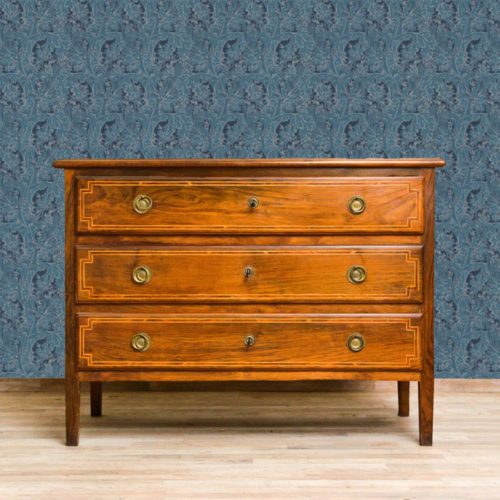 Directory chest of drawers with three drawers, Piedmontese origin, in walnut wood, late eighteenth century style. Threaded drawers in bois de rose and maple, truncated pyramidal legs. Invoice period about 1800. The chest of drawers is in excellent condition Period: late 18th century - early 19th century Measurements: H 91 X L 123 X P 55 cm
Directory chest of drawers with three drawers, Piedmontese origin, in walnut wood, late eighteenth century style. Threaded drawers in bois de rose and maple, truncated pyramidal legs. Invoice period about 1800. The chest of drawers is in excellent condition Period: late 18th century - early 19th century Measurements: H 91 X L 123 X P 55 cm -
Out of stock
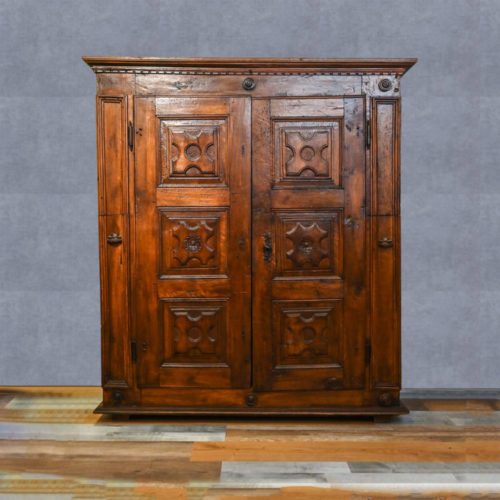 Piedmontese baroque cabinet in walnut, from the first half of the 18th century. Rebated doors with three carved panels each, smooth sides, the left one built in chestnut. Excellent condition, the piece of furniture was born as a single body and was subsequently cut in the middle to be easier to transport, a classic feature of antique Piedmontese furniture. Measurements: H 177 x W 147 x D 57,5 / Internal D 50 cm
Piedmontese baroque cabinet in walnut, from the first half of the 18th century. Rebated doors with three carved panels each, smooth sides, the left one built in chestnut. Excellent condition, the piece of furniture was born as a single body and was subsequently cut in the middle to be easier to transport, a classic feature of antique Piedmontese furniture. Measurements: H 177 x W 147 x D 57,5 / Internal D 50 cm